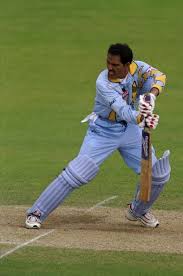In praise of Azhar
Gareth Bland |
Batsmen from the subcontinent seem to have a unique place in the imagination of English cricket fans. Bringing with them differences in technique and bearing the fruits of having learned their trade on totally different surfaces, their qualities are most often manifest in the subtle manipulation of a cricket bat which comes from dexterous wristwork.
From the great Ranji in the Golden Age through to the modern era, batsmen from India, Pakistan and Sri Lanka cast perhaps the most exotic of spells. One such exemplar, a native of Hyderabad in the southern Indian state of Telangana, was Mohammad Azharuddin. Although he was latterly overshadowed by India’s late 20th century quartet of Tendulkar, Ganguly, Dravid and Laxman, “Azhar” was, for a period, the very embodiment of eastern willow-wielding exoticism.
A man of inherent contradictions, perhaps Jonathan Rice best summarized this son of Hyderabad with his observation, in the Wisden on India Anthology, that “a Muslim educated at a Christian school, captaining the national side made up largely of Hindus and Sikhs, perhaps he never quite fitted in, but to watch him bat in his prime was sheer joy”. Nowhere was that joy and fascination more heartily felt than in England, against whom Azharuddin embarked on his Test career in the Indian summer of 1984/85.
Having debuted for Hyderabad in Indian domestic competition in 1981/82, Azhar was made to wait his turn for three full seasons during which time the national side had at their disposal such luminaries as Gundappa Viswanath, Sandeep Patil, Dilip Vengsarkar, Yashpal Sharma and Mohinder Amarnath. When the call came, in 1984/85 against David Gower’s touring England team, Azharuddin made his mark immediately and most emphatically. Making his Test debut at Kolkata on New Year’s Eve 1984, Azhar proceeded to cream centuries in three consecutive Tests, a feat not bettered since.
Strolling to the middle following the dismissal of his senior teammate and fellow Hyderabad native Mohinder Amarnath at 126/3, Azhar was finally dismissed with the score 341/5. Taking time to settle himself and eschewing risk, the 21 year-old compiled 214 for the fifth wicket with Ravi Shastri. Although the tourists had encountered the young batsman in earlier tour fixtures at Jaipur and Ahmedabad, the impression created here was one of watchfulness and assuredness of technique. Flamboyance and flair, given the match situation, were in short supply. As Wisden observed:
“A willowy 5ft 11in, he confirmed the impression made at Jaipur and Ahmedabad of placid temperament, sound technique and flawless application, batting 443 minutes before being caught in the gully from a ball that lifted off a length. After a well-contested first day, however, the tempo of Azharuddin’s stand with Shastri, which was India’s record in all Tests for the fifth wicket, killed the match. “
Despite being on the losing side in the next Test in Chennai, Azharuddin played with considerably more dash on that occasion as he notched 105 in India’s second innings 412. Charmed by his exhibition, Wisden noted “Azharuddin revealed a brilliant range of off-side strokes square with the wicket in becoming only the fourth player to score a hundred in his first two Tests before falling to Pocock, caught at silly point, early on the final day”.
His 122 in the final Test in Kanpur appeared to confirm that India had unearthed a special gem. Three centuries, a total of 439 runs and a mean of 109.75 announced to the cricketing world the arrival of this wiry, taciturn right-hander.
Azharuddin’s next encounter with England came in the early half of the 1986 English summer. In a series which was largely overshadowed by the FIFA World Cup in Mexico, and by Ian Botham’s suspension from international duties, the touring team nonetheless caught England cold, trouncing them 2-0 in the three Test rubber. In six Test innings Azharuddin notched 157 runs at 31.40 with a high of 64. Outshone with the bat by Dilip Vengsarkar, who was simply imperious on that tour, Azhar showed flashes of the magic which was due to come. In the two match ODI series at the summer’s dawn he stroked a masterly 83 at The Oval in the opening game, piloting his country to victory and easily outpacing Sunil Gavaskar in the run chase.
Little did anyone know it but it would be another four years before Azharuddin, India and England would lock horns once more. In 1988/89 England’s tour of India was cancelled due to the Indian authorities’ refusal to accept the involvement of previously SAB contracted English players and, in particular, to acknowledge a touring party captained by Graham Gooch. In 1990, however, it was the very same GA Gooch who captained England against India on home soil, while Azharuddin had by this time been elevated to the Indian captaincy.
Although the 1990 series between the two is most often remembered for the England captain’s ascent to greatness, the Indian skipper performed with a level of artistic brilliance which will not easily be dislodged from the memory banks of those who witnessed it. Despite going down to a 1-0 series defeat, Azharuddin produced two gems.
In India’s first innings 454 Azhar needed just 111 balls to produce a virtuoso 121, with an incredible 22 boundaries. Particularly harsh on a wayward Devon Malcolm, Azharuddin was not daunted by the match situation, in particular the mammoth 454 they initially required to avoid the follow-on. As he recalled, “It’s not as if we were always hitting the ball as if we wanted to take the cover off it. But there was so much loose bowling, especially from Malcolm, that it was easy to send the ball speeding down the slope.”
In the Old Trafford Test which followed his first innings 179 was rated even more highly still. Striking 21 fours and a six, Azharuddin recalled “I always knew that the ball was going when I aimed to hit it”. Indeed, Azhar’s total control over the direction of his strokes and the dexterity which he demonstrated in compiling his runs brings to mind John Arlott’s description of the incomparable Jack Hobbs’ similarly majestic adroitness. As Arlott recalled of his idol, “The Master” Hobbs:
“The spectator felt that the stroke he played seemed so natural as to be inevitable – or as if a choreographer had designed it as the rhythmically and poetically logical consequence of the bowler’s delivery”
Watching re-runs of Azharuddin’s “Twin Peaks” from that English summer, it is not difficult to attribute those very same qualities displayed by Hobbs almost a century earlier to Azhar in 1990. Seasoned Indian cricket writer R. Mohan acknowledged:
“Having made his name as a stylist who used the power of his wrists to create the mesmeric effect of strokes played late, he had often been struggling in his attempt to put percentages ahead of style. It was an index of his re-emerging batting personality that he should score the centuries which fascinated Englishmen so”
The 1990 series haul was 426 runs at 85.20, with a solitary fifty sitting alongside those two unforgettable hundreds. Aside from the leisurely off-side strokes which seemed to punctuate each innings, he revealed a signature leg-side shot which almost became his trademark. Moving towards the off-side, Azhar would turn the wrists toward midwicket as the ball made impact on bat, only for then to follow through with such ferocity that he looked likely to knock himself off kilter as a result. The resulting four, often untraceable from the moment of leaving the bat, was thrilling as it sped over the midwicket ropes.
England and India – and Azharuddin and Gooch – next met while England were touring during the 1992/93 season. A poor England were no match for India, who triumphed 3-0. Azharuddin’s 182 in the opening Test in Kolkota was compiled at a rate of 92.38 per hundred balls and was described by Wisden as “a masterpiece of uninhibited strokeplay matched with watchful defence”. Azhar’s 214 runs came at 71.33, while a diminutive son of Mumbai, Sachin Tendulkar, was establishing himself under Azharrudin’s tutelage.
Mohammad Azharuddin returned to England for the last time as a Test cricketer in 1996. Then 33, he was a man under siege, following a World Cup semi-final defeat to Sri Lanka months earlier which had seen his home fans burn effigies of him after the game. Under pressure from the start of the tour, relationships with his players were at times fraught, with Navjot Singh Sidhu returning home early following a row with his captain. Doubtless affected by the fall-out following the break-up of his marriage months earlier, Azhar was accused of isolating himself from his players. In the circumstances, a return of 42 runs from five Test innings was perhaps understandable.
It was a sad footnote to his sparkling career against England, although the earlier images will never dim in the eyes of cricket followers. In total, Azhar compiled 1278 runs against England at an average of 58.09. His six centuries and three fifties is proof of a man who scored heavily when well set. In full flight he was something truly special, though, and even the big four of Tendulkar, Dravid, Laxman and Ganguly would no doubt have to bend the knee to him in his most irresistible form. He was, as the Indian writer Dileep Premachandran observed, “a Michelangelo in the midst of housepainters”.
Azhar’s Test career record against England compares favourably to an overall mean of 45.03 from 99 Test matches and 6215 runs. In ODIs he was similarly prolific against English teams, having run up 911 runs at 65.07 in 24 matches, with a top score of 95* in early 1993. In a career total of 334 limited overs games for India, Azharuddin notched 9378 runs at 36.92, with seven centuries.
Like many batsmen of his vintage, however, the thorn in his side were the West Indies. In 14 Tests he failed to post a century against them, with a best of 97 as he totalled 539 runs at a comparatively meagre 28.36. An outstanding fieldsman, although he performed on a high plane in the shorter formats, the Test match was Azharuddin’s métier, just as it was with fellow Hyderabadi Laxman. Invariably batting third drop at the earliest, the Test match gave him the time and latitude to shape the team’s innings.
The English county game certainly benefited from his unique presence. In two seasons with Derbyshire he was the personification of politeness, modesty and kindness. Always on hand with a word for supporters and county members, he was invariably helpful to junior players and bore his rank as captain of one of the game’s elite cricketing nations with humility. In 1991 he hit 2016 first class runs at 59.29, including seven centuries and 10 fifties, with a further 500 in limited overs competition. Three years later, returning for a second stint, he hit 712 runs at 44.50 before the call of duty from India curtailed his county season.
Azhar clearly enjoyed his time with the county, recalling “I really enjoyed my time here, I am very proud to have represented Derbyshire and it is a beautiful place”. Of his work with the players themselves, he added ““I enjoyed playing with the likes of Devon Malcolm and Dominic Cork, who used to stay in my house and drive to games with me. I helped to teach Dominic how to be humble and I always knew he would play for England”. It was always felt that his influence was deep-rooted but in helping to instill a sense of humility in Dominic Cork, the English game’s debt to Mohammad Azharuddin is perhaps far more profound than anyone ever imagined.





Leave a comment